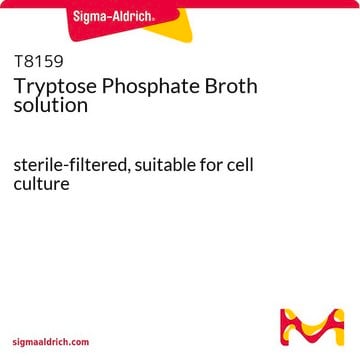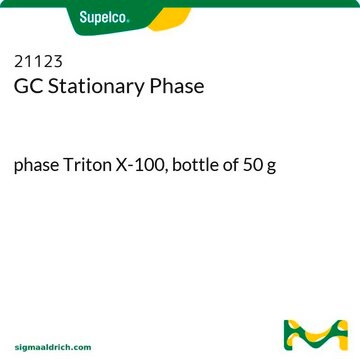T8787
Triton™ X-100
for molecular biology
Synonym(s):
t-Octylphenoxypolyethoxyethanol, Polyethylene glycol tert-octylphenyl ether
About This Item
Recommended Products
biological source
synthetic (organic)
grade
for molecular biology
description
non-ionic
form
liquid
mol wt
micellar avg mol wt 80,000
average mol wt 625
aggregation number
100-155
technique(s)
protein purification: suitable
protein quantification: suitable
western blot: suitable
impurities
<1.00% water (Karl Fischer)
pH
9.7
CMC
0.2-0.9 mM (20-25°C)
mp
6 °C
transition temp
cloud point 65 °C
pour point ~7 °C
solubility
water: 0.1 mL/mL, clear to slightly hazy, colorless to faintly yellow
density
1.06 g/mL at 25 °C (lit.)
cation traces
Fe: <5 ppm
K: <0.05%
Na: <0.1%
heavy metals: <5 ppm
HLB
13.5
application(s)
hematology
histology
foreign activity
DNase and RNase, none detected
storage temp.
room temp
SMILES string
CC(C)(C)CC(C)(C)c1ccc(OCCOCCOCCOCCOCCOCCOCCO)cc1
InChI
1S/C28H50O8/c1-27(2,3)24-28(4,5)25-6-8-26(9-7-25)36-23-22-35-21-20-34-19-18-33-17-16-32-15-14-31-13-12-30-11-10-29/h6-9,29H,10-24H2,1-5H3
InChI key
HNLXNOZHXNSSPN-UHFFFAOYSA-N
Looking for similar products? Visit Product Comparison Guide
General description
Application
- In immunohistochemistry for staining the Flat-mount retinas
- Along with ice-cold PBS (phosphate buffered saline) in suspension of cells for cell DNA analysis and Annexin V assay
- To permeabilise cells during Immunofluorescent microscopic studies
- As a positive control in LDH assay to determine the cell membrane integrity
- For estimating the lipase activity in postheparin plasma by using modified Belfrage and Vaughan radioenzymatic procedure
- For the preparation of outer membrane protein exctract
- As a component of extraction buffer along with tris-HCl, NaCl, CaCl2, ZnCl2, Brij 35 for homogenization of mice lung cells
- In the treatment of tissue sections for Immunofluorescence labeling
Biochem/physiol Actions
Features and Benefits
- Ideal for sensitive molecular biology research applications
- Tested for DNase and RNase
- Non-ionic nondenaturing detergent
- Superior wetting agent and emulsifier
- Highly versatile surfactant
Other Notes
Legal Information
comparable product
Signal Word
Danger
Hazard Statements
Precautionary Statements
Hazard Classifications
Acute Tox. 4 Oral - Aquatic Acute 1 - Aquatic Chronic 1 - Eye Dam. 1 - Skin Irrit. 2
Storage Class Code
10 - Combustible liquids
WGK
WGK 3
Flash Point(F)
483.8 °F - closed cup
Flash Point(C)
251 °C - closed cup
Personal Protective Equipment
Certificates of Analysis (COA)
Search for Certificates of Analysis (COA) by entering the products Lot/Batch Number. Lot and Batch Numbers can be found on a product’s label following the words ‘Lot’ or ‘Batch’.
Already Own This Product?
Find documentation for the products that you have recently purchased in the Document Library.
Customers Also Viewed
Protocols
Preparation for biodegradable nanoparticles and their use in transfection protocols .
Preparation for biodegradable nanoparticles and their use in transfection protocols .
Preparation for biodegradable nanoparticles and their use in transfection protocols .
Preparation for biodegradable nanoparticles and their use in transfection protocols .
Related Content
Cell lysis and protein extraction methods overview various techniques, from detergent solubilization to mechanical disruption, supporting research needs.
Cell lysis and protein extraction methods overview various techniques, from detergent solubilization to mechanical disruption, supporting research needs.
Cell lysis and protein extraction methods overview various techniques, from detergent solubilization to mechanical disruption, supporting research needs.
Cell lysis and protein extraction methods overview various techniques, from detergent solubilization to mechanical disruption, supporting research needs.
Our team of scientists has experience in all areas of research including Life Science, Material Science, Chemical Synthesis, Chromatography, Analytical and many others.
Contact Technical Service








